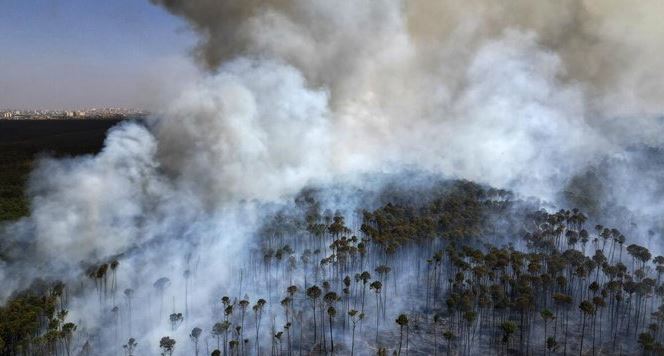Intense wildfires in the Amazon rainforest and other regions of Brazil have caused severe smoke pollution, affecting major cities like São Paulo and Rio de Janeiro and drifting into neighboring countries. Karla Longo, a researcher at the National Institute for Space Research (INPE), reported that satellite imagery indicates 60 percent of Brazil has been impacted by smoke. The affected area, including regions in neighboring countries and the Atlantic Ocean, spanned approximately ten million square kilometers (3.8 million square miles) as of Sunday.
Authorities in Argentina and Uruguay confirmed that smoke from the Brazilian fires had reached parts of their countries on Monday.

São Paulo, Latin America’s largest city, topped the global pollution index on Monday, according to air quality monitoring company IQAir. The concentration of fine particulate matter in the air reached 69 micrograms per cubic meter, nearly 14 times the World Health Organization’s recommended limit. In Rio de Janeiro, fine particle levels were reported to be five times the recommended limit.
The recent fires, primarily attributed to human activity linked to agricultural practices, have been exacerbated by Brazil’s worst drought in seven decades, a situation experts link to climate change.

US National Oceanic and Atmospheric Administration (NOAA) satellite images showed a dense cloud of smoke stretching along the Andes mountain range toward the southern continent. Meteorologist Estael Sias noted that winds are directing the smoke southward.
INPE data reveals that the number of fires in the Amazon this year has nearly doubled compared to the same period in 2023. The Chapada dos Veadeiros National Park, located about 250 kilometers from Brasilia, has lost around 10,000 hectares of vegetation to recent wildfires.

Sias warned that the situation is unlikely to improve without regular rainfall, which is not expected until October or November.
Key Points:
- Severe Smoke Pollution: Intense wildfires in the Amazon and other regions of Brazil are causing heavy smoke pollution in major cities like São Paulo and Rio de Janeiro and affecting neighboring countries.
- Extent of Smoke Impact: Satellite images show that 60% of Brazil is covered by smoke, with the affected area extending to around ten million square kilometers (3.8 million square miles).
- Air Quality Concerns: São Paulo has been identified as the world’s most polluted major city, with fine particulate matter levels nearly 14 times above the World Health Organization’s recommended limit. Rio de Janeiro also reported fine particle levels five times the recommended limit.
- Cross-Border Effects: Smoke from Brazil’s wildfires has been reported in Argentina and Uruguay.
- Fire Causes and Climate Impact: The fires, largely linked to agricultural activities, are intensified by Brazil’s worst drought in seven decades, attributed to climate change.
- Satellite Observations: NOAA satellite images show a thick cloud of smoke extending along the Andes.
- Increased Fire Activity: The number of fires in the Amazon this year has nearly doubled compared to 2023, with significant damage reported in Chapada dos Veadeiros National Park.
- Outlook: Meteorologists predict that the situation will not improve without regular rainfall, expected only in October or November.



